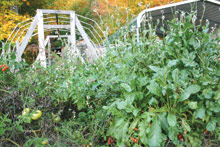As leaves fall and a late frost arrives, I gaze at my garden. I’ve been busy these past few weeks, and now I’m weighed down by the guilt of all the unfinished garden tasks. Driving to work, I’ve seen other gardens freshly plowed, cleared of their brown cornstalks and rotting tomatoes. Mine remains a mix of cleared sections, tangled tomato vines and a few rows of young collard greens.

The ‘Matt’s Wild Cherry’ tomatoes, for example, keep producing juicy red clusters, so I’ve let them linger. A few winter squash—the deep red-orange ‘Potimarron’ and the big, green, oval ‘Sweet Keeper’—lie ripening among yellow-brown bean vines. A few rows of dark-green collards still thrive in the crisp weather. Sweet-sorghum canes wave nut-brown seed heads in the breeze. I’ve picked a few for fall flower arrangements, and I’ll save some for next year, though what makes me sad is that I may not be gardening this plot next year. Where I’ll be planting all my saved seeds—‘Fife Creek’ okra, ‘Williams Striped’ tomatoes, Russian kale and others—I’m just not sure.
With a blend of hope, sorrow and anxiety, my partner and I have placed our little farm on the market. We’re selling so we can move closer to town. We’re hopeful because there’s no lack of special homes in the Asheville area awaiting good stewards. We’re sad to leave this remote yet beautiful spot in the middle of a national forest. We’re anxious because the economy is a mighty depressing mess, and selling could take awhile.
But there’s something stubbornly idealistic about farmers. Every year my grandfather planted corn, though some years he didn’t get enough for one baby raccoon to savor. And in my case, there’s the added element of rookie mistakes. I planted water-loving tomatoes during a drought and found myself committed to many hours of hand-watering. I planted green beans but didn’t factor in how much my neighborhood deer would enjoy the crop. I planted sweet sorghum simply because it made me think of chewing on sweet canes when I was a kid, and I wondered how it would fare on my mountainside (the canes would have been thicker if it had received more sun and a little more water, but otherwise it thrived). I calculated and estimated growth patterns, laying out garden sections with a measuring tape—only to watch some varieties defy my expectations (the description on the ‘Matt’s’ seed packet claimed it was a spreader; this proved to be no exaggeration, as the low-growing vines intruded into adjacent rows faster than the Invasion of the Body Snatchers). One row of banana peppers got lost in the ‘Matt’s’ jungle and may not be seen until I dig up the section.
Still, amid the uncertainties, I ponder next year. Will I try new varieties? Will my farm sell before it’s time to plant, come spring? Will I be planting a small urban garden at a new home?
In any case, I hope I’ve learned a thing or two. Gardening is a bit like living your life. You try this or that, see what works (or doesn’t), clean up your messes and your successes, and move on.
Meanwhile, this year’s edition of The Dirt will also end soon—our last offering will appear in the Oct. 29 issue. But I’ll be thinking of gardens and greenery during the cold months ahead. I’ll peruse seed catalogs, read garden books and dream of spring. For now, though, I’m musing on the many ways to enjoy collards.



Before you comment
The comments section is here to provide a platform for civil dialogue on the issues we face together as a local community. Xpress is committed to offering this platform for all voices, but when the tone of the discussion gets nasty or strays off topic, we believe many people choose not to participate. Xpress editors are determined to moderate comments to ensure a constructive interchange is maintained. All comments judged not to be in keeping with the spirit of civil discourse will be removed and repeat violators will be banned. See here for our terms of service. Thank you for being part of this effort to promote respectful discussion.